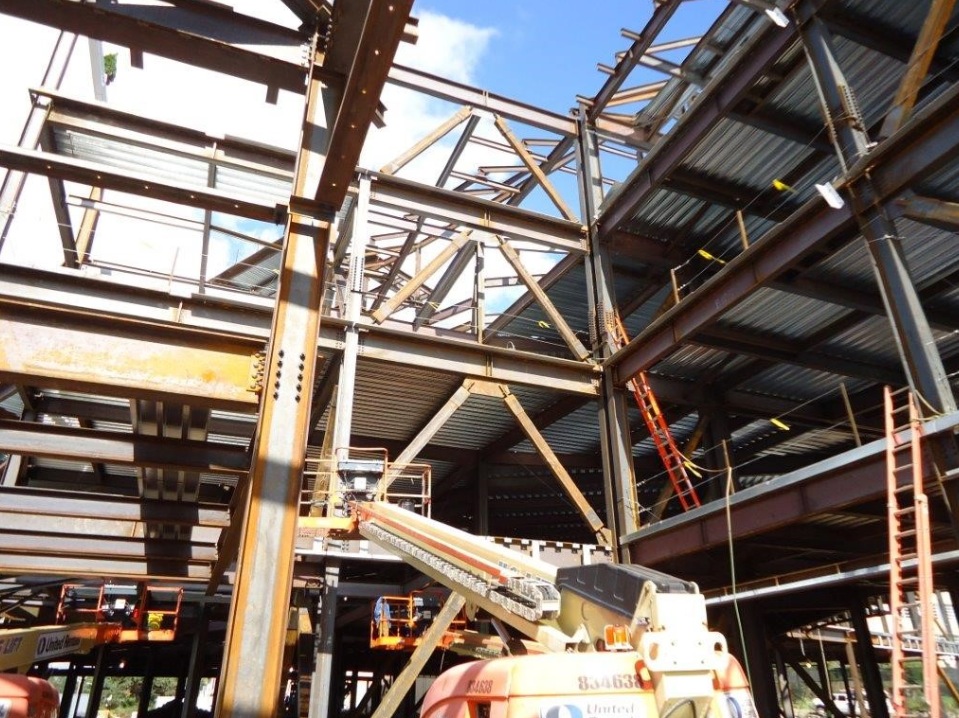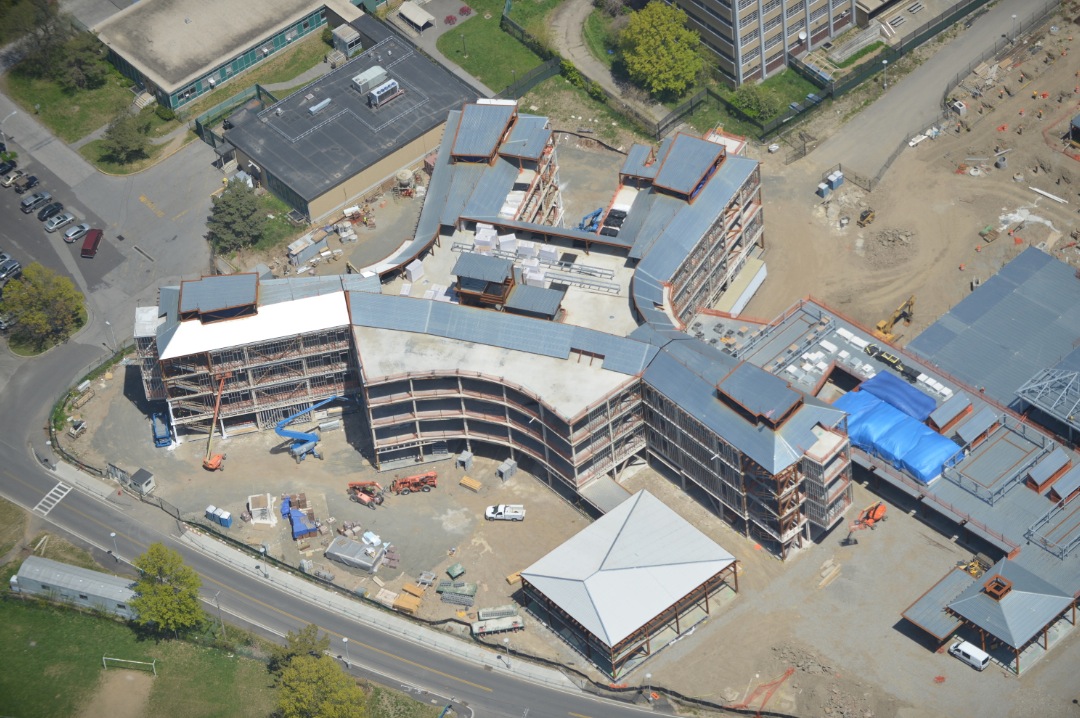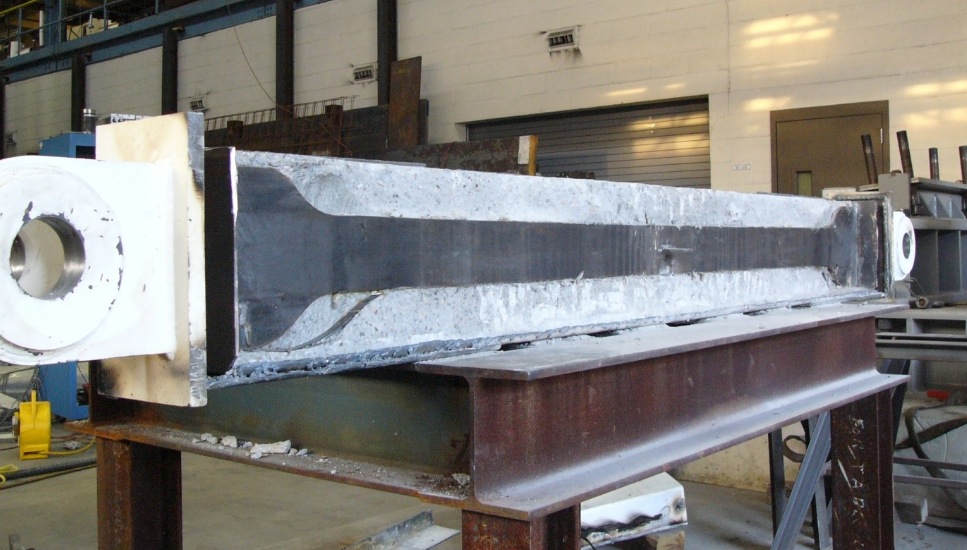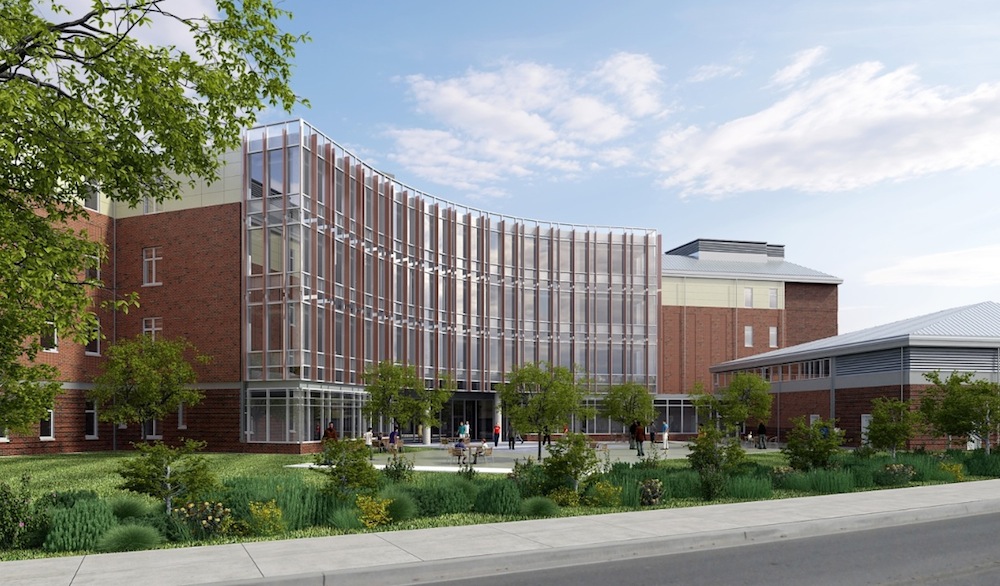The buckling restrained braced frame system was introduced to the U.S. construction market in 1999 as a solution for meeting hardened building codes following the 1994 Northridge earthquake. Since then, BRBF has been used to stabilize hundreds of buildings along the West Coast, especially in earthquake-prone California.
As seismic codes play a larger role in building projects east of the Sierras, Building Teams across the country are turning to seismic design solutions like BRBF that were perfected in the West to meet increasingly stringent code requirements.
The latest example is the five-story, 179,000-sf Adult Behavioral Health Center, recently completed as part of the Dormitory Authority of the State of New York’s rebuilding of the Bronx Psychiatric Center campus, on behalf of the New York State Office of Mental Health.
Unlike many large-scale New York City structures built on solid rock foundations, the 156-bed Bronx healthcare facility is situated on wetlands that had been filled in with four million cubic yards of material generated from the construction of the Cross Bronx Expressway from 1948 to 1972. The poor soil conditions resulted in a Site Class F categorization and a Seismic Design Category D for the site. It called for an expanded geotechnical investigation and assessment, as well as seismic mitigation measures that were recently implemented under the New York State Building Code.
 Situated on wetlands, the five-story, 179,000-sf Adult Behavioral Health Center in the Bronx, N.Y., required special seismic mitigation measures. Buckling restrained braces were the most economical, efficient solution.
Situated on wetlands, the five-story, 179,000-sf Adult Behavioral Health Center in the Bronx, N.Y., required special seismic mitigation measures. Buckling restrained braces were the most economical, efficient solution.
The structural design team, led by STV, first considered a traditional concentric braced frame lateral system. The solution met seismic requirements, but posed space-planning concerns for the client. Its relatively sizable structural elements and supporting walls would have bumped up against the health center’s programmatic requirements for rooms and circulation and would have jeopardized the architect’s open, airy indoor design scheme.
The final design approach, developed in conjunction with engineers in STV’s Los Angeles office, called for a BRBF system—a first for the Northeast—to enhance the structural performance of the building and greatly reduce steel frame member sizes. It also minimized the number of supporting walls needed for the project, and saved approximately $500,000 in material costs, according to Chris Cerino, PE, SECB, VP and Director of Structural Engineering, Building & Facilities Division, with STV. The firm also served as the design architect and electrical, civil, geotechnical, and telecom engineer on the project.
With the BRBF approach, certain braced frame steel columns could be downsized from W14x426 to W14x342, and select braced frame steel beams were reduced from W36x150 to W24x68.
“Smaller frame members gave STV designers flexibility in considering the movement of staff, residents, and food and building services,” says Cerino. “It also improved sightlines in all staff and resident areas to reduce the dependency on electronic monitoring.”

Buckling restrained braces (BRBs) vary slightly based on the manufacturer, but all BRBs include five basic components: a steel-plate core shaped like a kayak paddle (1) is placed within a hollow steel tube (2) that is coated with a low-friction material (3), which is then grouted in place (4) and capped (5). The grouted steel tube design prevents the steel core from buckling when in compression, while the coating prevents axial load from being transferred to the encasement.
The result is a “full, balanced response in relation to the forces being applied,” says Cerino. “Because the steel core is restrained, it develops nearly uniform axial strains across the section, resulting in efficient energy dissipation.”
This balanced energy dissipation, in turn, permits design teams to use much smaller beam sizes than with a standard braced frame.
On the Adult Behavioral Health Center project, Cerino’s team specified a proprietary system manufactured by Star Seismic. According to Cerino, Star’s Wildcat BRB system, which features single-pin connections, reduced erection time because it eliminated the need for stiffener plates. “Its patented collar reduces welding, since simple fillets can be used,” says Cerino. “That factored into the overall monetary savings.”
Cerino offers a few tips for Building Teams evaluating BRBFs:
- Watch out for the added special seismic requirements and details that become triggered when using a high-performance seismic system. “Not that a BRBF has different triggers than a special concentrically braced frame system, but since much of the design is deferred to the specialty brace contractor, some of the details can become out of sight, out of mind,” he says.
- Decide on the system early so you can address any client/procurement obstacles. “If it becomes too late, it can simply be easier to do nothing,” says Cerino. “That doesn’t help the project.”
 Buckling restrained braces include several basic components: a steel-plate core is placed within a hollow steel tube that is coated with a low-friction material and then grouted in place and capped. The grouted steel tube design prevents the steel core from buckling when in compression, while the coating prevents axial load from being transferred to the encasement.
Buckling restrained braces include several basic components: a steel-plate core is placed within a hollow steel tube that is coated with a low-friction material and then grouted in place and capped. The grouted steel tube design prevents the steel core from buckling when in compression, while the coating prevents axial load from being transferred to the encasement.

Related Stories
Engineers | Jun 5, 2023
How to properly assess structural wind damage
Properly assessing wind damage can identify vulnerabilities in a building's design or construction, which could lead to future damage or loss, writes Matt Wagner, SE, Principal and Managing Director with Walter P Moore.
Cladding and Facade Systems | Jun 5, 2023
27 important questions about façade leakage
Walter P Moore’s Darek Brandt discusses the key questions building owners and property managers should be asking to determine the health of their building's façade.
Office Buildings | May 15, 2023
Sixteen-story office tower will use 40% less energy than an average NYC office building
This month marks the completion of a new 16-story office tower that is being promoted as New York City’s most sustainable office structure. That boast is backed by an innovative HVAC system that features geothermal wells, dedicated outdoor air system (DOAS) units, radiant heating and cooling, and a sophisticated control system to ensure that the elements work optimally together.
AEC Tech Innovation | May 12, 2023
Meet Diverge, Hensel Phelps' new ConTech investment company
Thai Nguyen, Director of Innovation with Hensel Phelps, discusses the construction giant's new startup investment platform, Diverge.
University Buildings | May 5, 2023
New health sciences center at St. John’s University will feature geothermal heating, cooling
The recently topped off St. Vincent Health Sciences Center at St. John’s University in New York City will feature impressive green features including geothermal heating and cooling along with an array of rooftop solar panels. The geothermal field consists of 66 wells drilled 499 feet below ground which will help to heat and cool the 70,000 sf structure.
Mass Timber | May 3, 2023
Gensler-designed mid-rise will be Houston’s first mass timber commercial office building
A Houston project plans to achieve two firsts: the city’s first mass timber commercial office project, and the state of Texas’s first commercial office building targeting net zero energy operational carbon upon completion next year. Framework @ Block 10 is owned and managed by Hicks Ventures, a Houston-based development company.
AEC Tech | May 1, 2023
Utilizing computer vision, AI technology for visual jobsite tasks
Burns & McDonnell breaks down three ways computer vision can effectively assist workers on the job site, from project progress to safety measures.
Design Innovation Report | Apr 27, 2023
BD+C's 2023 Design Innovation Report
Building Design+Construction’s Design Innovation Report presents projects, spaces, and initiatives—and the AEC professionals behind them—that push the boundaries of building design. This year, we feature four novel projects and one building science innovation.
Design Innovation Report | Apr 19, 2023
HDR uses artificial intelligence tools to help design a vital health clinic in India
Architects from HDR worked pro bono with iKure, a technology-centric healthcare provider, to build a healthcare clinic in rural India.
3D Printing | Apr 11, 2023
University of Michigan’s DART Laboratory unveils Shell Wall—a concrete wall that’s lightweight and freeform 3D printed
The University of Michigan’s DART Laboratory has unveiled a new product called Shell Wall—which the organization describes as the first lightweight, freeform 3D printed and structurally reinforced concrete wall. The innovative product leverages DART Laboratory’s research and development on the use of 3D-printing technology to build structures that require less concrete.

















